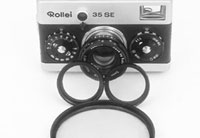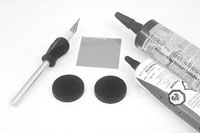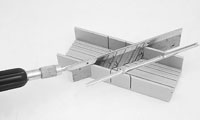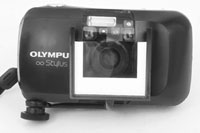Black And White In Your Point-And-Shoot
Where There's A Will, There's A Way!
If taking pictures in black and white is a regular part of your photographic way of life, then it must puzzle and frustrate you a bit, as it does me, that the makers of most point-and-shoot cameras seem to have never heard of black and white film. Otherwise why would they produce hundreds of otherwise fun little cameras with absolutely no means of using filters on them? Granted, black and white snapshooters are few and far between among the masses of general picture-taking consumers, but serious photo hobbyists hate being forced to give up filter capability. After all, how much extra would it cost to add filter threads to a lens? |
||||||
Black and white fans shopping for a new point-and-shoot should look for a few critical features. First, obviously, would be a model that accepts filters. The bad news is that there aren't many. Contax is the only manufacturer that I'm familiar with that consistently provides filter threads on their point-and-shoot camera lenses. The original T and TVS models, along with the current T2, TVS II, and TIX (APS), all accept 30.5mm screw-in filters (an adapter is required with the TIX), as do all of the vintage Rollei 35-series cameras with the 40mm f/2.8 Sonnar lens. You won't find 30.5mm filters (or any of several other small, "oddball" filter sizes) in your average photo department, but B+W (Schneider) and Heliopan (HP Marketing) filters in this size can be special ordered from camera stores that cater to professionals. At least one regular Shutterbug advertiser, KOH's Camera, keeps several of the most popular tints in stock. Most photographers will simply be looking to add a couple of basic filters to their compact camera, such as a medium yellow and an orange, or perhaps a yellow and a polarizer, so they won't go broke needlessly duplicating their SLR's filter arsenal. |
||||||
Another important feature is
some means of compensating for the filter factor, in order to avoid underexposing
the film. An exposure compensation dial is ideal, but a manual ISO setting
(override) capability will serve nearly as well. |
||||||
If you rarely use black and white in your compact camera, or just want to see if it can be done with your particular camera, a gelatin filter, a pair of scissors, and some double-stick (adhesive on both sides) tape provide a quick-and-dirty means of filtration. A bit of tape above and below the lens suffice to anchor a small square of filter gel. Incidentally, although I've used Kodak Wratten gels for ages, I've recently discovered Calumet's polyester gels; they're much more durable, can be cleaned, and are more reasonably priced. If your camera has no means of dialing in exposure compensation, then you'll need to cover the meter cell/window with a bit of gel also. If you're not sure which of the umpteen little windows on the front of your camera is the meter cell, check the parts/features diagram in your instruction book; mistakenly covering an AF sensor can wreak havoc in the picture sharpness department. |
||||||
Should you desire a little
more substantial means of filtration, you will have two basic choices:
a press-fit filter, or a bracket arrangement that holds a home-brew filter
in front of the lens; which is more appropriate will depend on your particular
camera. |
||||||
I tried all of my old standbys--Ambroid, Duco, Testor's Plastic Cement, Weldwood, Pliobond, etc.--all to no avail. Industrial solvents up to the task are dangerous and not available in small quantities. Fortunately, I finally stumbled upon a tube of clear sealant called "Lexel" at the hardware store. It claimed to stick to just about anything, including wet surfaces, and they were right. Again, if your camera has no exposure compensation, you'll also have to tape a piece of filter gel over the meter cell; if it has compensation, you're home free. This press-fit solution works well with the telescoping zoom lenses on many of today's popular compacts. If your camera's lens retracts behind a sliding cover, be sure to remove the filter before turning the camera off. |
||||||
Using some sort of spring-clamping
arrangement to attach the filter to the lens may occur to you. If you
decide to try it, proceed with caution; excessive clamping pressure could
damage plastic telescoping lens mounts, or distort the optics. |
||||||
How you support this slide holder depends on your camera. A bracket arm can be attached to the camera via a tripod socket or an accessory shoe. The Olympus Stylus Infinity shown doesn't have a shoe, so the bracket arm was soldered to three brass washers, through which a tripod screw fastens it to the tripod socket. After soldering the holder to the arm and painting to match the camera, you're ready to take (filtered) pictures. This Olympus' lens is too close to the various sensors, so the top of the slide mount was cut off; a projecting "tab" of filter gel covers the meter cell, providing exposure compensation. With larger cameras, you probably won't need to trim the slide mounts. The brass tubing used for the bracket arm can be bent with minimal kinking with the aid of a tubing bender; hobby shops currently seem to be stocking only the spring-type benders (K&S Engineering, No. 321), but the wheel-type is better (but more expensive) if you can find them. |
||||||
To attach the bracket arm via
an accessory shoe, just bend the arm to insert into a hole drilled in
a discarded flash attachment foot; make sure the arm doesn't obstruct
any of the camera's sensors. |
||||||
Calumet Photographic Products
(Polyester filter gels) Contax |
||||||
HP Marketing Corp. (Heliopan
filters) KOH's Camera Sales &
Services (30.5mm B+W and Heliopan filters) |
||||||
Sashco Sealants, Inc. (Lexel
sealant) Schneider Optics, Inc. (B+W
filters) |
||||||
|
||||||
|















































